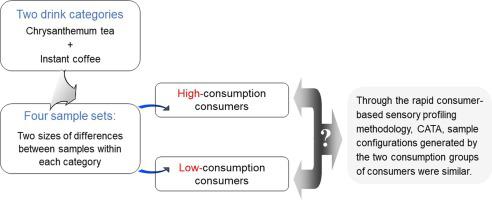Food Research International ( IF 8.1 ) Pub Date : 2020-06-04 , DOI: 10.1016/j.foodres.2020.109378 Yixun Xia , Jiahui Song , PuiYee Lee , Huijuan Shen , Jiaoliang Hou , Jian Yang , Boyang Gao , Fang Zhong

|
Check-All-That-Apply (CATA) is a very popular tool for rapid sensory profiling in consumer research. Yet, consumers’ dietary habits, such as consumption frequency, has been neglected in regard to the impact, if any, on CATA question responses. The present work aimed to fill this gap, by focusing on the effect of different consumption frequencies with four studies (N = 686). Two categories of drink products were involved, chrysanthemum tea and instant coffee. For each category, two sets of products were prepared to constitute two levels of difference between samples (larger vs. smaller). Consumers were classified into high- and low-consumption groups according to their consumption frequencies of each focal product; the size of these subgroups ranged from 54 to 130. Overall, the two groups did not produce large discrepancies from each other when constructing sensory profiling of the tested samples with CATA questions as well as the stability of sample configurations. However, there were some nuances between them. In the evaluation of chrysanthemum tea samples, the higher-consumption group of consumers presented better discrimination than the lower-consumption group while this was reversed for coffee samples. This might be mainly attributed to the fact infrequent consumers were more sensitive to such negative attributes as “strong chrysanthemum smell for chrysanthemum samples, earthy for coffee samples”. Further, despite the higher stability obtained with larger sizes of difference between samples in Studies 3 and 4, in general, the effect of size of differences within sample sets was not significant between different consumption groups. To more effectively contribute to refinement of methodological guidelines for CATA questions, more validation work is needed.
中文翻译:

消费频率对使用CATA问题的感官产品概况的影响:两种饮料类别的案例研究
Check-All-That-Apply(CATA)是在消费者研究中快速进行感官分析的一种非常流行的工具。但是,就对CATA问题回答的影响(如果有的话)而言,消费者的饮食习惯(例如消费频率)已被忽略。本工作旨在通过四项研究(N = 686)关注不同消耗频率的影响来填补这一空白。涉及两类饮料产品,菊花茶和速溶咖啡。对于每种类别,准备了两组产品,以构成样本之间的两个差异水平(较大与较大)。较小)。根据每个重点产品的消费频率,将消费者分为高消费和低消费组。这些亚组的大小在54到130之间。总体而言,在构建带有CATA问题的被测样品的感官特征以及样品配置的稳定性时,两组之间彼此之间没有太大差异。但是,它们之间有些细微差别。在菊花茶样品的评估中,高消费群体的消费者比低消费群体的歧视性更好,而咖啡样本则相反。这可能主要归因于这样的事实,即很少有消费者对诸如“菊花样品的菊花味浓,咖啡样品的土味”等负面属性更加敏感。进一步,尽管在研究3和4中,样品之间的差异较大,但稳定性更高,总体而言,不同消费组之间样品组差异大小的影响并不显着。为了更有效地为完善CATA问题的方法指南做出贡献,需要进行更多的验证工作。



























 京公网安备 11010802027423号
京公网安备 11010802027423号